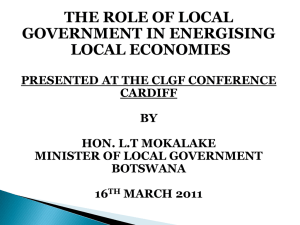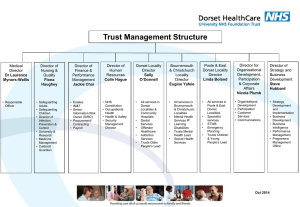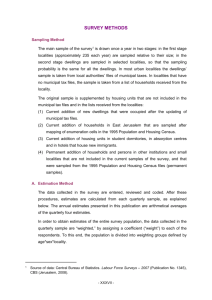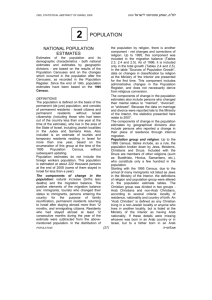POPULATION
advertisement
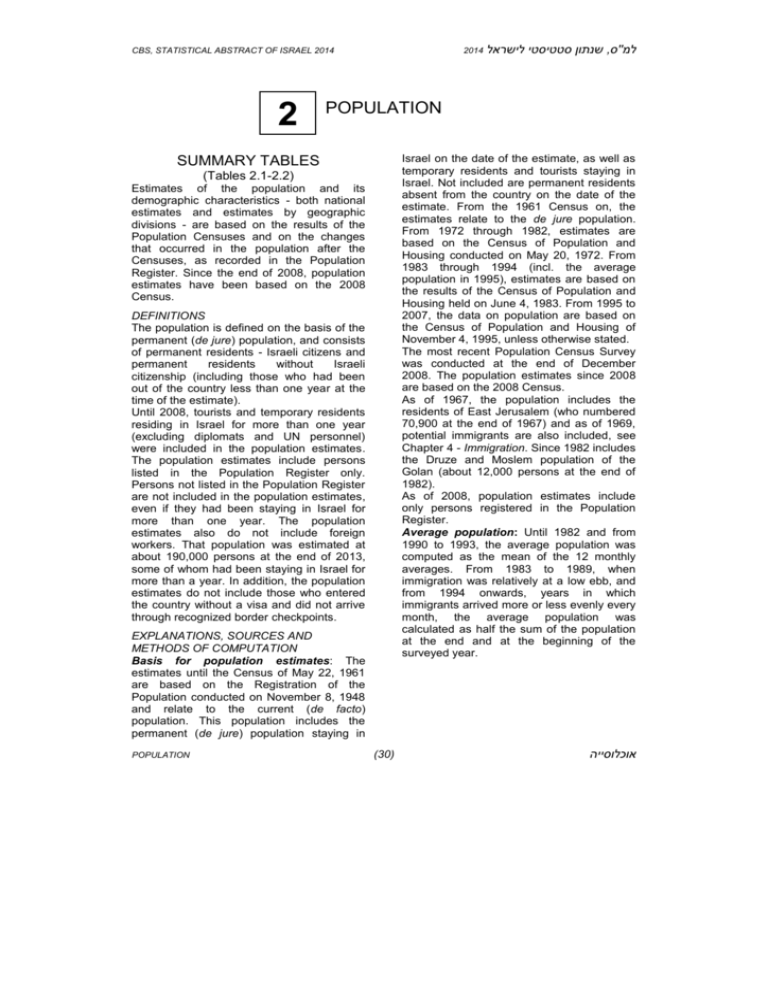
2014 CBS, STATISTICAL ABSTRACT OF ISRAEL 2014 2 POPULATION Israel on the date of the estimate, as well as temporary residents and tourists staying in Israel. Not included are permanent residents absent from the country on the date of the estimate. From the 1961 Census on, the estimates relate to the de jure population. From 1972 through 1982, estimates are based on the Census of Population and Housing conducted on May 20, 1972. From 1983 through 1994 (incl. the average population in 1995), estimates are based on the results of the Census of Population and Housing held on June 4, 1983. From 1995 to 2007, the data on population are based on the Census of Population and Housing of November 4, 1995, unless otherwise stated. The most recent Population Census Survey was conducted at the end of December 2008. The population estimates since 2008 are based on the 2008 Census. As of 1967, the population includes the residents of East Jerusalem (who numbered 70,900 at the end of 1967) and as of 1969, potential immigrants are also included, see Chapter 4 - Immigration. Since 1982 includes the Druze and Moslem population of the Golan (about 12,000 persons at the end of 1982). As of 2008, population estimates include only persons registered in the Population Register. Average population: Until 1982 and from 1990 to 1993, the average population was computed as the mean of the 12 monthly averages. From 1983 to 1989, when immigration was relatively at a low ebb, and from 1994 onwards, years in which immigrants arrived more or less evenly every month, the average population was calculated as half the sum of the population at the end and at the beginning of the surveyed year. SUMMARY TABLES (Tables 2.1-2.2) Estimates of the population and its demographic characteristics - both national estimates and estimates by geographic divisions - are based on the results of the Population Censuses and on the changes that occurred in the population after the Censuses, as recorded in the Population Register. Since the end of 2008, population estimates have been based on the 2008 Census. DEFINITIONS The population is defined on the basis of the permanent (de jure) population, and consists of permanent residents - Israeli citizens and permanent residents without Israeli citizenship (including those who had been out of the country less than one year at the time of the estimate). Until 2008, tourists and temporary residents residing in Israel for more than one year (excluding diplomats and UN personnel) were included in the population estimates. The population estimates include persons listed in the Population Register only. Persons not listed in the Population Register are not included in the population estimates, even if they had been staying in Israel for more than one year. The population estimates also do not include foreign workers. That population was estimated at about 190,000 persons at the end of 2013, some of whom had been staying in Israel for more than a year. In addition, the population estimates do not include those who entered the country without a visa and did not arrive through recognized border checkpoints. EXPLANATIONS, SOURCES AND METHODS OF COMPUTATION Basis for population estimates: The estimates until the Census of May 22, 1961 are based on the Registration of the Population conducted on November 8, 1948 and relate to the current (de facto) population. This population includes the permanent (de jure) population staying in POPULATION שנתון סטטיסטי לישראל,למ''ס )30( אוכלוסייה members of Jewish immigrants. It also includes members of religions that were not specified separately (Buddhists, Hindus, Samaritans, etc.), that were included with the Druze until 1995. In the 1995 Census this population (Buddhists, Hindus, Samaritans, etc.) comprised about 400 persons. In the 2008 Census, members of those religions numbered about 1,200 persons. As of 2000, the overall population also includes Southern Lebanese citizens (soldiers from the Southern Lebanese Army and their families) who entered Israel in May 2000 and were given Israeli identity cards. At the end of 2013, this population comprised about 2,600 persons, about 1,700 of whom are not classified by religion in the Population Register. In the tables that present data by religion, this group is listed as part of the total population and the Arab population, but is not included in the specification of religions. Age is defined as the number of completed years at the estimation date. Marital status includes: never-married, married, divorced, and widowed. Marital status is based on the Population Register. Country of birth is defined by borders at the time of the estimate, with the exception of the USSR, Yugoslavia and Czechoslovakia. Data on those countries relate to the political situation before their dissolution. Continent/country of origin for persons born abroad - continent/country of birth; for persons born in Israel father’s continent/country of birth. DEMOGRAPHIC CHARACTERISTICS OF THE POPULATION (Tables 2.3-2.9) Population group and religion: In the tables with data by population group, the division (as of 1995) is as follows: - Jews - Arabs: Moslems (incl. Circassians), ArabChristians (incl. Armenians), and Druze. - Others: Non-Arab Christians, members of other religions, and not classified by religion in the Population Register. Until the 1995 Census, Others were included in the Arab population. In the tables with data by religion, the division is as follows: - Jews - Moslems - Christians: (Arab Christians and Non-Arab Christians) - Druze - Not classified by religion Until the 1995 Census, tables included a breakdown of the population by religion, as follows: Jews, Moslems, Christians (including those not classified by religion), and Druze (including members of other religions such as: Buddhists, Hindus, Samaritans, etc.), Starting with the 1995 Census, due to the arrival of many immigrants not listed as Jews in the Population Register, the definitions of religion and population group were revised. The Christian group was divided into two groups - Arab Christians, and non-Arab Christians. The division was made according to type of locality of residence, nationality, and country of birth. Arab Christians: Any Christian living in a non-Jewish locality, or anyone living in another locality whose nationality is listed as Arab in the Population Register. If these details were missing, anyone born in an Arab country or in Israel to a father born in an Arab country was included in the group of Arab Christians. Non-Arab Christians: The rest of the Christians. Not classified by religion: Another group that has been presented separately since 1995. This group usually relates to family POPULATION POPULATION PROJECTIONS (Table 2.10) The projections are based on the population estimates at the end of 2010, as well as on various assumptions about the anticipated developments from that year until the end of 2035. The projections presented here are based on three different assumptions regarding the level of fertility and the migration balance, and one assumption regarding mortality. JEWISH POPULATION IN THE WORLD AND IN ISRAEL )31( אוכלוסייה include persons who reported a change in their place of residence through internal migration. Due to the method of calculation, as of 2009 the total growth does not amount to the sum of all sources of growth. (Table 2.11) Source: The Division of Jewish Demography and Statistics, The A. Harman Institute of Contemporary Jewry, The Hebrew University of Jerusalem. SOURCES OF POPULATION GROWTH GEOGRAPHICAL DISTRIBUTION OF THE POPULATION (Tables 2.12-2.14) DEFINITIONS The components of change in the population: Natural increase (births less deaths) and the migration balance. The positive elements of the migration balance are: immigrants, tourists who changed their status to immigrants, persons entering the country for the purpose of family reunification, permanent residents returning to Israel after staying abroad more than 12 months, and immigrating citizens. (An immigrating citizen is a person who was born to an Israeli citizen while that citizen was staying abroad, and who entered Israel with the intention of settling in the country.) Residents who had stayed abroad at least 12 consecutive months during the year of the estimate were subtracted from the abovementioned population. The increase in geographic distributions is also affected by internal migration, see below. In the distribution of the population by religion, there is another component - net changes and corrections of religion. Up to 1995, this component was included in the migration balance (Tables 2.12, 2.13 and 2.14). As of 1996, it is included only in the total growth (Tables 2.13 and 2.14). In the table “Sources of Population Growth”, data on changes in classification by religion recorded in the Population Register are presented as of 2008. This component includes administrative changes in the Population Register, and does not necessarily derive from religious conversion. The components of change in the population estimates also include persons who changed their marital status to “married”, “divorced”, or “widowed”. Because the data on marriage and divorce were reported late to the Population, Immigration and Border Authority, the statistics presented here relate to 2011. The components of change in the population estimates by geographical divisions also POPULATION (Tables 2.15-2.25) DEFINITIONS Locality is a permanently inhabited place that meets the following criteria: a. It is usually inhabited by 40 or more adult residents (until the 1961 Census - 10 residents and until 1997 - 20 permanent residents or more); b. It has self-administration; c. It is not officially included in another locality. d. Its establishment was approved by the planning institutions. Localities are classified as “Jewish” or “nonJewish” according to the majority population in the locality. In most localities, there is a large majority either of “Jews” or of “Arabs”. In Israel, there are nine localities defined as "mixed". Of those, eight are urban localities that have a large majority of Jews, but also have a considerable minority of Arabs: Jerusalem, Tel Aviv-Yafo, Haifa, Akko, Ramla, Lod, Ma'alot-Tarshiha, Nazerat Illit (since 1983) and the rural locality Neve Shalom (since 1985). These localities were counted as both “Jewish” and “non-Jewish” localities, but in the total localities they were counted only once. The population listed under the religion “Jews” refers to Jews living in Jewish or non-Jewish localities. The population listed under the Arab population group refers to Arabs living in non-Jewish or Jewish localities. District and sub-district: The districts and sub-districts are defined according to the official administrative division of the State of Israel, which includes 6 districts and 15 subdistricts, including Israeli localities in the Judea and Samaria Area. )32( אוכלוסייה localities consist of family units, each of which is an independent economic entity. Part of the production and economic administration is carried out by the cooperative society, the degree of cooperation being determined by the members. Collective moshav is a rural collective locality, where production and marketing are collective and consumption is private. Kibbutz is a rural collective locality where production, marketing and consumption are collective. Institutional locality: An Institution that has the characteristics of a locality and is not within the municipal boundaries of another locality. Communal locality: A locality organized as a cooperative society, which has no right to farm land, and where the domains and extent of cooperative activities (production, consumption, municipal and social activities) are determined by its members. After the 1995 Census, communal localities were removed from the "other rural locality" category and classified as a separate type of locality. In addition, adaptations to the 1983 Census data were made accordingly. Other rural locality: A locality numbering less than 2,000 residents which is not included in any of the other categories described above. Living outside localities: Residents living outside the boundaries of any locality. In the places inhabited by this population, all of the definitions that characterize a locality (presented above) do not apply. This group is included in the rural population. Bedouin tribes: The Bedouin population living outside of localities, mainly in the Negev and in northern Israel (since the 1983 Census, this population has been included among those "living outside localities"). Bedouin tribes are not recognized localities, and are therefore not included in the count of localities. Reports of changes in personal data (e.g., marriages, divorces, etc.) at the Population, Immigration and Border Authority among the Bedouins in the South are incomplete. In addition, the Bedouins often indicate the name of their tribe instead of the locality in which they live when asked to give their address. Because the Bedouin tribes are The changes in "district and sub-district" are as follows: Since 1967, the Jerusalem District includes East Jerusalem. Since 1972, Israeli localities in the Judea and Samaria and Gaza Areas, the Golan Heights, and Sinai are included. Since 1981, the Golan Sub-District is included in the Northern District. Since 1982, Israeli localities that were evacuated from Sinai are excluded. Since August 2005, Israeli localities in the Gaza Area and northern Samaria that were evacuated under the Disengagement Plan Law in 2005 are excluded. Natural region: Within the frame of the official division into 15 sub-districts, a more detailed sub-division was made into natural regions. Each natural region is part of one sub-district or, in some cases, identical to a whole sub-district. Natural regions are continuous areas, as homogeneous as possible in their physical structure, climate and soil, as well as in the demographic, economic and cultural characteristics of their population. Before the 2008 Census, the natural region system was updated and the number of regions rose to 50. After the 2008 Census, they numbered 51. The Lod Natural Region was divided into the Modi’in and Ramla natural regions. TYPE OF LOCALITY Localities in Israel are divided into two categories: urban and rural localities. Urban localities include all localities with 2,000 or more residents and are classified by size (also including rural types of localities with a population of over 2,000). As of the 2008 Census, new divisions were made in the classification of urban localities. Localities with 200,000+ residents were split into two categories: 200,000-499,999 residents, and 500,000+ residents. Localities with 2,000-9,999 residents were also split into two categories: 2,000-4,999 residents, and 5,000-9,999 residents. Rural localities include all localities with a population of less than 2,000 (even if they are not agricultural or rural in character). Rural localities are sub-divided as follows: Moshav is a rural locality, organized as a cooperative society which has the right to agricultural farm land, as defined by the Israel Land Administration. These POPULATION )33( אוכלוסייה considered as "living outside localities", these reports may cause people to be registered as having moved from localities to areas outside of localities. In addition, this leads to excessive registration of births among those living outside localities, and to unreasonable birth rates and age composition. As a result, it is difficult to estimate the proportion of the Bedouin population outside localities, and especially to determine the characteristics of the Bedouin population remaining within and outside localities. Place: A place is a new area that has begun to be populated, but still does not meet the criteria for being defined as a locality. Therefore, places are not included in the count of localities. Population density: Total population per square kilometer of land area. Since 1981, the Golan Sub-District has been included in the calculation of population density. The Judea and Samaria Area is not included in the calculation of population density. Therefore, in calculating the population density of the Tel Aviv metropolitan area and the Jerusalem metropolitan area, the Israeli localities of the Judea and Samaria Area were not included. area and the Haifa metropolitan area. From 2001-2012, three metropolitan areas were defined: Tel Aviv, Haifa, and Be’er Sheva. As of 2013, in accordance with the recommendation of the Committee for Municipal Statistics and Geographical Classifications and following the decision of the CBS, the boundaries of the existing metropolitan areas (Tel Aviv, Haifa and Be’er Sheva) were updated and a fourth metropolitan area – the Jerusalem metropolitan area – was defined. Tel Aviv Metropolitan Area: A new section was defined in the outer ring for the Israeli localities in the Judea and Samaria Area. In accordance with the recommendation of the Committee, the localities in this section were added as points, without territorial continuity between each locality. Haifa Metropolitan Area: A limited number of localities were added and many localities were subtracted in this metropolitan area. Be’er Sheva Metropolitan Area: Only one outer ring was defined (compared with the previous division in which inner, middle and outer rings were defined). The new division significantly limited the number of localities included in the metropolitan area. Jerusalem Metropolitan Area: The fourth metropolitan area, which was added in 2013 consists of a core – the city of Jerusalem – and an outer ring. The outer ring has two sections: western and eastern. In the eastern section, the Israeli localities in the Judea and Samaria Area are included in the metropolitan area as points without territorial continuity between each locality. METROPOLITAN AREAS Metropolitan area: A large number of urban localities (municipalities and local councils) and rural localities in regional councils, which are adjacent to one another, and constitute one functional entity that integrates economic, social and cultural relations. The metropolitan areas were divided according to their internal structure. Core: The territory of the primary city serving as the focus of activity for the population of the metropolitan area. Inner Ring: The area containing the localities surrounding the core. Middle ring: The area containing the localities surrounding the Inner Ring (only in the Tel Aviv and Be’er Sheva metropolitan areas). Outer Ring: The area containing the localities surrounding the Middle Ring. Sections (Northern, Eastern, Southern and Western); subdivisions of the metropolitan rings. Until 2000, two metropolitan areas were defined in Israel: the Tel Aviv metropolitan POPULATION MUNICIPAL STATUS OF LOCALITIES: Three types of local authorities are distinguished: Municipality refers to one locality only. Local council refers to one locality only. Regional council refers, generally, to a number of rural localities. Regional councils include localities with a representative on the council, as well as localities within the municipal jurisdiction of the council that are not represented in it. The latter, however are included in the number of localities in the council, and their population is included in the population of that council. In addition, there are a few localities without any municipal status. As of the 2008 Census, data on the )34( אוכלוסייה population by municipal status do not include "living outside localities" in the estimate of regional councils. Until the 2008 Census, "living outside localities" was included in the area of regional councils where they live. Changes in Status of Localities The main changes in status of localities during 2013 were as follows: 1. The locality Irus was established in the Gan Raveh regional council in the Central District, and added with the status of a "place". 2. The communal locality Eliav in the Lakhish regional council was added in the Southern District. 3. The establishment of the communal locality Rehalim in the area of the Shomeron regional council was approved. 4. The establishment of the locality Sansana in the area of the Har Hevron regional council was approved, and the removal of the locality Sansana from the Bene Shimon regional council in the Southern District, following the corresponding revision of the locality’s boundary definition. 5. Three localities with the status of a "place" (Mahane Yattir, Bene Dkakim, and Nezer Hazani) changed their status, and were included in the count of localities in 2013. considerable increase in the number of changes registered Regional Council was since 1982, and one should be cautious in comparing data with previous years. In 2003, population estimates were affected by underreporting due to a strike at the Ministry of the Interior. In 2004, the estimates were affected by updating registration of movements from the previous year. The data on internal migration are registration data. The data include all persons who reported a change of address to the Population, Immigration and Border Authority until 31 December 2013, even if the change itself took place before. Tables 2.13 and 2.14 present data on population growth in geographic divisions due to internal migration. INTERNATIONAL COMPARISONS (Table 2.28) This paragraph presents comparisons of statistical data on Israel with data on other countries, particularly countries that are members of the Organization for Economic Cooperation and Development (OECD). Different countries tend to publish their data using definitions and formats that are convenient for them. Therefore, in order to solve problems related to the accuracy of comparisons, this paragraph presents information that is usually taken from the sources of international organizations such as the United Nations, OECD, ILO, etc., which prepare data in a way that allows for comparison. INTERNAL MIGRATION (Tables 2.26-2.27) SOURCES Data for all of the countries, excluding Israel, were taken from the UNSTATS - the World Bank website. Data for land area: http://data.worldbank.org/indicator/SP.POP.T OTL Data for the population: http://data.worldbank.org/indicator/AG.LND.T OTAL.K2 The data on Israel were obtained from data published by the Central Bureau of Statistics, see Chapter 1 - Geophysical Characteristics, Table 1.1, and Chapter 2 - Population, Tables 2.1, 2.14. The data on internal migration between localities are based on analysis of the file of changes recorded in the Population Register of the Population, Immigration and Border Authority according to the residents' notification of a change of address. The data do not include the new immigrants’ first place of settlement, but include their changes of address. Changes of address include changes from one locality to another locality in the same district or changes to a locality in another district. As of the end of 1981, changes of address have also been registered on the basis of passport application forms, identity card applications and birth notifications; the use of birth notification was discontinued in mid1990. Consequently, there has been a POPULATION )35( אוכלוסייה SELECTED PUBLICATIONS 10A SPECIAL PUBLICATIONS 1109 Internal Migration in Israel of Immigrants of the 1990s, 1997 1182 Demographic Characteristics of the Population in Israel, 1995-1999 1185 Ethiopian Population in Israel Demographic Characteristics, 19961999 1223 Persons Aged 60 and Over in Israel: Findings from a Survey Conducted in 1997-1998 1271 Immigrant Population from the Former USSR - Demographic Trends 19902001 CURRENT BRIEFINGS IN STATISTICS 11, 1998 Population in Localities with 2,000 and More Inhabitants Selected Demographic Data from the 1995 Census of Population and Housing. 4, 2004 Internal Migration in Israel, 1999-2000. 11, 2004 Immigrant Population from the Former USSR, Selected Data, 2000-2001 CENSUS OF POPULATION AND HOUSING 1995 1 Population and Household Provisional Results 3 List of Localities - Geographical Characteristic and Population - 19481995 7 Demographic Characteristics of the Population in Localities and Statistical Areas 8A Socio-Economic Characteristics of Population and Households in Localities with 2,000 Inhabitants and More - Selected Findings (Hebrew only) POPULATION Level of Education of the Population in Israel - Selected Findings (Hebrew only) )36( PUBLICATIONS APPEARING ONLY ON THE CBS WEBSITE - Population Projections for Israel up to 2035 - Internal Migration in Israel, 2001-2002. - Internal Migration in Israel, 2003-2005. - Localities in Israel 2003-2006 (Hebrew only). - Kibbutzim and their Population: Demographic Changes between 1991 and 2005. - Ethiopian Population in Israel Demographic Characteristics, 2006 - Population Census 2008 – 2008 data - Report on the Demographic Situation of Israel, 2011 - Metropolitan Areas in Israel Based on 2008 Census Data אוכלוסייה
